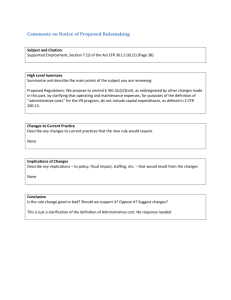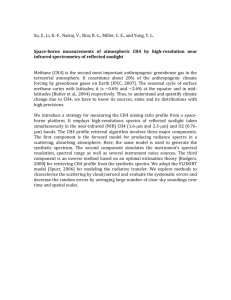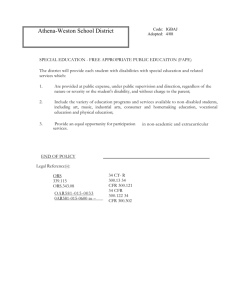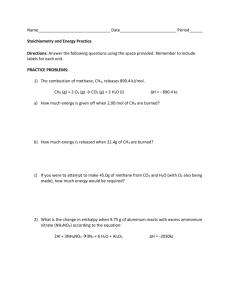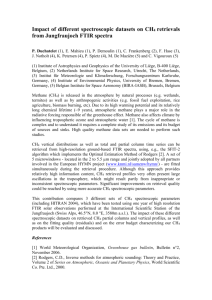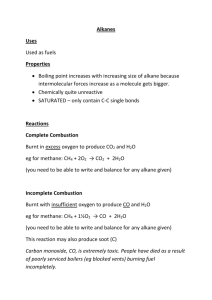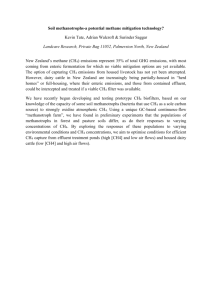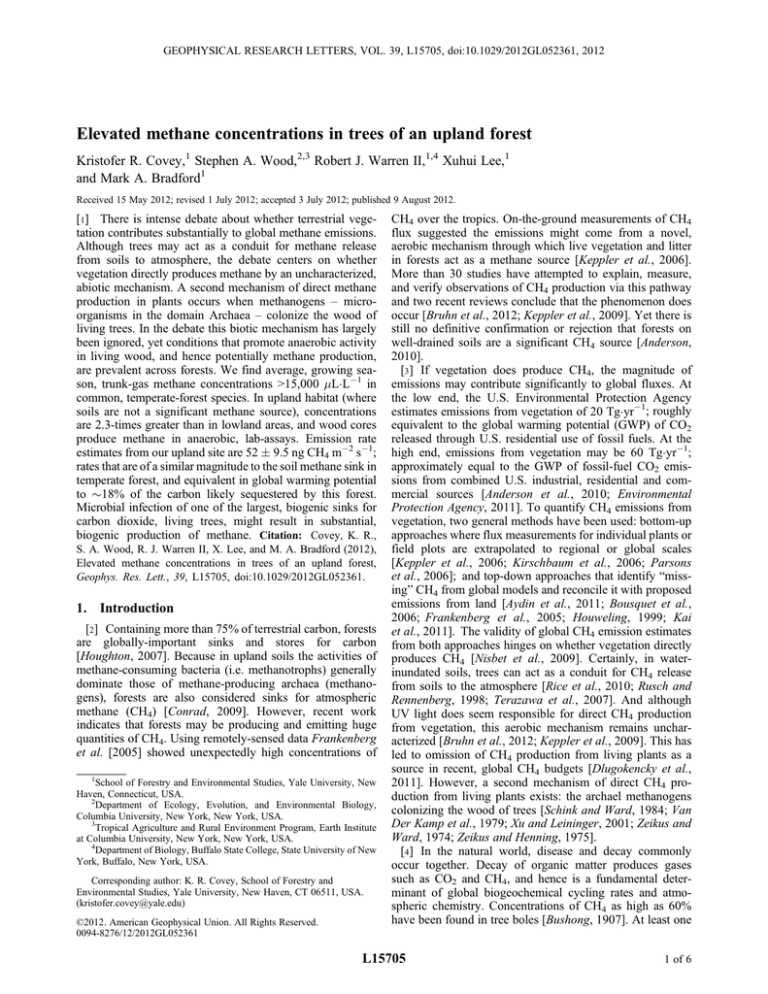
GEOPHYSICAL RESEARCH LETTERS, VOL. 39, L15705, doi:10.1029/2012GL052361, 2012
Elevated methane concentrations in trees of an upland forest
Kristofer R. Covey,1 Stephen A. Wood,2,3 Robert J. Warren II,1,4 Xuhui Lee,1
and Mark A. Bradford1
Received 15 May 2012; revised 1 July 2012; accepted 3 July 2012; published 9 August 2012.
[1] There is intense debate about whether terrestrial vegetation contributes substantially to global methane emissions.
Although trees may act as a conduit for methane release
from soils to atmosphere, the debate centers on whether
vegetation directly produces methane by an uncharacterized,
abiotic mechanism. A second mechanism of direct methane
production in plants occurs when methanogens – microorganisms in the domain Archaea – colonize the wood of
living trees. In the debate this biotic mechanism has largely
been ignored, yet conditions that promote anaerobic activity
in living wood, and hence potentially methane production,
are prevalent across forests. We find average, growing season, trunk-gas methane concentrations >15,000 mLL1 in
common, temperate-forest species. In upland habitat (where
soils are not a significant methane source), concentrations
are 2.3-times greater than in lowland areas, and wood cores
produce methane in anaerobic, lab-assays. Emission rate
estimates from our upland site are 52 9.5 ng CH4 m2 s1;
rates that are of a similar magnitude to the soil methane sink in
temperate forest, and equivalent in global warming potential
to 18% of the carbon likely sequestered by this forest.
Microbial infection of one of the largest, biogenic sinks for
carbon dioxide, living trees, might result in substantial,
biogenic production of methane. Citation: Covey, K. R.,
S. A. Wood, R. J. Warren II, X. Lee, and M. A. Bradford (2012),
Elevated methane concentrations in trees of an upland forest,
Geophys. Res. Lett., 39, L15705, doi:10.1029/2012GL052361.
1. Introduction
[2] Containing more than 75% of terrestrial carbon, forests
are globally-important sinks and stores for carbon
[Houghton, 2007]. Because in upland soils the activities of
methane-consuming bacteria (i.e. methanotrophs) generally
dominate those of methane-producing archaea (methanogens), forests are also considered sinks for atmospheric
methane (CH4) [Conrad, 2009]. However, recent work
indicates that forests may be producing and emitting huge
quantities of CH4. Using remotely-sensed data Frankenberg
et al. [2005] showed unexpectedly high concentrations of
1
School of Forestry and Environmental Studies, Yale University, New
Haven, Connecticut, USA.
2
Department of Ecology, Evolution, and Environmental Biology,
Columbia University, New York, New York, USA.
3
Tropical Agriculture and Rural Environment Program, Earth Institute
at Columbia University, New York, New York, USA.
4
Department of Biology, Buffalo State College, State University of New
York, Buffalo, New York, USA.
Corresponding author: K. R. Covey, School of Forestry and
Environmental Studies, Yale University, New Haven, CT 06511, USA.
(kristofer.covey@yale.edu)
©2012. American Geophysical Union. All Rights Reserved.
0094-8276/12/2012GL052361
CH4 over the tropics. On-the-ground measurements of CH4
flux suggested the emissions might come from a novel,
aerobic mechanism through which live vegetation and litter
in forests act as a methane source [Keppler et al., 2006].
More than 30 studies have attempted to explain, measure,
and verify observations of CH4 production via this pathway
and two recent reviews conclude that the phenomenon does
occur [Bruhn et al., 2012; Keppler et al., 2009]. Yet there is
still no definitive confirmation or rejection that forests on
well-drained soils are a significant CH4 source [Anderson,
2010].
[3] If vegetation does produce CH4, the magnitude of
emissions may contribute significantly to global fluxes. At
the low end, the U.S. Environmental Protection Agency
estimates emissions from vegetation of 20 Tgyr1; roughly
equivalent to the global warming potential (GWP) of CO2
released through U.S. residential use of fossil fuels. At the
high end, emissions from vegetation may be 60 Tgyr1;
approximately equal to the GWP of fossil-fuel CO2 emissions from combined U.S. industrial, residential and commercial sources [Anderson et al., 2010; Environmental
Protection Agency, 2011]. To quantify CH4 emissions from
vegetation, two general methods have been used: bottom-up
approaches where flux measurements for individual plants or
field plots are extrapolated to regional or global scales
[Keppler et al., 2006; Kirschbaum et al., 2006; Parsons
et al., 2006]; and top-down approaches that identify “missing” CH4 from global models and reconcile it with proposed
emissions from land [Aydin et al., 2011; Bousquet et al.,
2006; Frankenberg et al., 2005; Houweling, 1999; Kai
et al., 2011]. The validity of global CH4 emission estimates
from both approaches hinges on whether vegetation directly
produces CH4 [Nisbet et al., 2009]. Certainly, in waterinundated soils, trees can act as a conduit for CH4 release
from soils to the atmosphere [Rice et al., 2010; Rusch and
Rennenberg, 1998; Terazawa et al., 2007]. And although
UV light does seem responsible for direct CH4 production
from vegetation, this aerobic mechanism remains uncharacterized [Bruhn et al., 2012; Keppler et al., 2009]. This has
led to omission of CH4 production from living plants as a
source in recent, global CH4 budgets [Dlugokencky et al.,
2011]. However, a second mechanism of direct CH4 production from living plants exists: the archael methanogens
colonizing the wood of trees [Schink and Ward, 1984; Van
Der Kamp et al., 1979; Xu and Leininger, 2001; Zeikus and
Ward, 1974; Zeikus and Henning, 1975].
[4] In the natural world, disease and decay commonly
occur together. Decay of organic matter produces gases
such as CO2 and CH4, and hence is a fundamental determinant of global biogeochemical cycling rates and atmospheric chemistry. Concentrations of CH4 as high as 60%
have been found in tree boles [Bushong, 1907]. At least one
L15705
1 of 6
COVEY ET AL.: METHANE IN UPLAND FORESTS
L15705
L15705
Table 1. Species-Level Differences in CH4 Production, Timber Volume and Susceptibility to Fungal Decay
Species
Mean Production
Potential
(mg CH4 m3 s1)
Percent of
Cores Showing
CH4 Production
Range of
Productiona
(mg CH4 m3 s1)
Standing Bole
Volume
(m3 ha 1)
Percentage of
Volume Lost
to Heart Rotb
Pinus strobus L. (eastern white pine)
Tsuga canadensis L. (eastern hemlock)
Quercus rubra L. (red oak)
Betula lenta L. (black birch)
Acer rubrum L. (red maple)
0.067
0.115
0.107
1.555
1.239
40
40
60
80
60
.161–.175
.190–.383
.165–.192
.191–6.884
.236–3.522
8.6
11.5
28.2
8.6
8.6
5%
12%
19%
21%
21%
a
Range of production includes only those samples demonstrating measureable production of CH4. Reported means are for all samples.
Wagener and Davidson [1954].
b
source of high trunk-gas CH4 concentrations has been
known for more than forty years: bacterial infection of
heartwood (i.e. non-living tissue that primarily accumulates
in trunks as trees age). This infection promotes wetwood
and, with it, production of CH4 through classical methanogenesis [Zeikus and Ward, 1974]. Wetwood CH4 production
has not been quantified for its contribution to global CH4
emissions [Conrad, 2009]. Similarly, neither have contributions from heart rot – the decay of heartwood instead
caused by fungal infection [Boyce, 1961] – which also promotes anaerobic decay and colonization by methanogens,
but is much more prevalent in living trees. Indeed, in temperate forests 20% of the commercial timber harvest, for
genera such as oaks and maples, is lost to fungal decay
[Wagener and Davidson, 1954]. Notably, symptoms of heart
rot are often not outwardly visible for standing trees [Zillgitt
and Gevorkiantz, 1948] and anaerobes can be active before
decay is measurable [Shortle et al., 1978; Wilcox, 1970].
[5] In low O2 and high CO2 environments, such as those
in tree trunks [Teskey et al., 2008], aerobic heart-rot fungi
are incapable of completing their metabolic processes
[Jensen, 1967; Schmidt, 2006]. This incomplete fermentation provides substrates suitable for use by bacteria and
archaea. In turn, these bacteria and archaea accelerate fungal
growth by removing the waste products of fungal metabolism and by enriching the wood substrate through N-fixation
[Beckmann et al., 2011]. These syntrophic (i.e. “feeding
together”) consortia are capable of breaking down complex
biopolymers that individual organisms cannot digest [Bryant
et al., 1967]. Such consortia are known to degrade wood and
produce CH4 in ruminant animals [Bauchop, 1981; Joblin
and Naylor, 1989], in digesters [Zinder, 1993] and in timbers stored under conditions similar to those found inside
living trees [Beckmann et al., 2011; Krüger et al., 2008].
Even in predominately aerobic environments, fungal
metabolism can lead to anaerobic microsites and the formation of large quantities of CH4 by archaea [Reith et al.,
2002].
[6] Given the expectation of widespread and abundant
fungal infection of living wood, we selected individuals in
lowland and upland habitat of six trees species that vary in
their vulnerability to heart rot [Scheffer, 1966] and that
commonly occur in temperate forest. We reasoned that if
trees primarily serve as conduits of CH4 release from soils to
the atmosphere, then we should only observe elevated CH4
concentrations in tree trunks where the soil might be a significant CH4 source (i.e. lowland habitat). A second source in
these lowland habitats would be wetwood, which would also
yield elevated CH4 concentrations in trees. In contrast, in
upland habitat the soil is a CH4 sink and wetwood is rare. We
therefore reasoned that elevated CH4 concentrations in tree
trunks of species known to be susceptible to fungal-mediated
heart rot would suggest an abundant and widespread CH4
production source in living trees. Using trunk-gas CH4 concentrations, and lab-based CH4 production potentials from
wood samples, we provide estimates of emissions from living
trees of CH4 produced by the microbial consortia that occur
with heart rot.
2. Methods
2.1. Field and Laboratory Measurements
[7] Because decay is more likely to be found in larger and
older trees [Berry and Beaton, 1972; Browne, 1956; Zillgitt
and Gevorkiantz, 1948], we selected 58 trees with diameters at breast height (dbh; 1.3 m) >25 cm (indicative in our
region of mature, canopy trees in middle-aged stands). Trees
were selected by order-of-encounter, stratified across six
species (Table 1), in lowland and well-drained upland habitat
at Yale-Myers Forest, Connecticut, USA (Lat. 41 56′15″
Long. 72 10′45″). Stands were of similar age-class (80–
100 years), and representative of the oak-dominated hardwood forest type common to the eastern U.S. [Meyer and
Plusnin, 1945].
[8] To determine in situ trunk-gas CH4 concentrations,
prior to (April) and post (July) leaf-out in 2011, trees were
drilled horizontally at breast height to center with a 5/16″
drill bit (Speedbor, Irwin, Huntersville, NC, USA) and
immediately plugged with an 8-mm stopper (SubaSeal,
Sigma-Aldrich, St. Louis, MO, USA). A 50-mL gas-syringe
(SGE, Ringwood, AU) was inserted through the SubaSeal
and into the cavity to remove 50 mL of trunk-gas from
each tree, 15 mL of which was injected into a vacuum-sealed
12-mL pre-evacuated sample vial (Exetainer, Labco, High
Wycombe, UK) and 0.2 mL analyzed by gas chromatography on an FID Gas Chromatograph (310C, SRI, Menlo Park,
CA, USA) equipped with a 1-m silica-gel column, with
helium as a carrier gas and an oven temperature of 40 C.
[9] We evaluated trunk-gas CH4 concentrations using
General Linear Mixed Models to assess effect of habitat and
time of year, with tree species as a random factor, therefore
accounting for spatial and temporal associations in our sampling design. To discern species-level differences, we used
ANOVA to assess time-of-year by species effects. All models were run in the statistical freeware R [R Development
Core Team, 2010].
[10] To confirm that trunk-wood had the potential to
produce CH4, in October 2011 we removed bark-to-pith
increment cores from the same trees, sectioned them to fit in
37-mL anaerobic bottles, flushed them with 50 mL of 100%N2 and returned them to the laboratory within 12 h of
collection. Headspaces were flushed again with N2 for 3 min
2 of 6
COVEY ET AL.: METHANE IN UPLAND FORESTS
L15705
at 1 Lmin1 and incubated for 12 h at 20 C, after which a
15 mL sample was withdrawn and measured in the same
manner as the trunk-gas samples. These lab assays only
provide evidence for CH4 production from trunk wood and
rate comparisons are probably not reliable. For example,
CH4 production can drop rapidly following disturbance of
methanogenic communities and similar assays with wetwoodinfected materials show that N2 assays underestimate production potentials by a factor of 3 [Mukhin and Voronin,
2011; Zeikus and Ward, 1974].
2.2. Scaling to Field Rates for Upland Forest
[11] Past work investigating tree-mediated CH4 transport
from anoxic soils has demonstrated that CH4 diffuses
through bark [Gauci et al., 2010; Pulliam, 1992; Rusch and
Rennenberg, 1998; Terazawa et al., 2007], and studies of
other trunk gases have shown bark flux rates are positively
and linearly related to trunk gas concentrations [Steppe et al.,
2007]. Given these relationships, we estimated in situ bark
effluxes for our upland site from trunk-gas CH4 concentrations and radial diffusivity in wood. Ignoring longitudinal
diffusion, we obtain the diffusion equation in the cylinder
coordinate as:
r1 ∂w
F ¼ f rra D
r2 ∂r r2
where F is the radial diffusion flux, f is a radial diffusivity
scale factor (= 0.017) [Zohoun et al., 2003] similar to the
tortuosity factor used to describe gas diffusion in soils, r is
air filled-porosity estimated to be 0.07 according to the
water content reported for wet wood [Nord-Larsen et al.,
2011], ra is air density, D is CH4 diffusivity in ambient
air (= 0.21 cm2 s1, [Massman, 1998], w is CH4 molar
mixing ratio, and r1 and r2 are the radius of the heartwood
and tree trunk, respectively. We used the mean tree radius
(r2 = 23.5 cm) and assumed the central half of this radius was
heartwood (r1 = 11.7 cm), giving 11.7 cm of trunk wood for
CH4 diffusion. The mixing ratio gradient at r1 was estimated
from the observed difference in the mixing ratio between the
trunk air and ambient air. The flux computed from the above
equation has the dimensions of mg CH4 m2 s1 (unit surface
area of the tree trunk) and was converted to mg CH4 m3 s1
(unit wood volume) for the purpose of upscaling. Mean calculated flux rates were scaled to per hectare field rates using
standing live bole volume (Table 1) estimated from region
and species-specific volume equations [Meyer and Kienholz,
1944]. Volumes estimates were based on randomized variableradius plot sampling (n = 5 plots) in our upland site using a
factor 10 basal area prism (Cruise Master, Forestry Suppliers,
Jackson, MS, USA). Emissions from those species not sampled (11% of total volume), where scaled using the mean
concentration of all sampled species.
3. Results and Discussion
[12] Our data suggest that trees – by supporting environments suitable for classical methanogenesis – could make
upland forests significant contributors to global CH4 emissions. At our upland site, trunk-gas CH4 concentrations were
as high as 80,000 times atmospheric, and mean growingseason concentrations in the three species (red maple, red
oak, black birch; Table 1) known to be most susceptible to
L15705
heart rot were above 15,000 mL L1 (Figure 1), leading to
species-level differences in CH4 trunk-gas concentrations
(P < 0.01). A similar trend across species was present in lab
assays with black birch and red maple producing more
consistently and at higher rates than the two conifer species
studied (eastern white pine, eastern hemlock). These assays
confirm the production of significant quantities of methane
in outwardly healthy tree wood under anaerobic headspace.
The large variation present may be due to high spatial variability of production within individuals or could stem from
the sensitivity of microbial communities to disturbance. We
assessed increment cores and found visible decay was not
correlated with trunk-gas CH4 concentrations and/or production potentials. This lack of correlation is not surprising,
and we would not expect a direct correlation with rot for
several reasons. For example, trees may respond to injury
and microbial infection by generating anoxia in trunk wood,
favoring methanogens but generating little visible decay
[Shortle, 1979]. It is at these decay frontiers where microsites favoring methanogenesis are most likely to occur and
advanced decay would likely reduce or shut-down methanogenesis because it increases permeability facilitating O2
diffusion [Schwarze, 2007; Sorz and Hietz, 2006]. Notably,
in the upland site, we had a red maple individual in which
the center was hollow and trunk CH4 concentrations
approximated those in ambient air.
[13] Trunk CH4 concentrations were 2.3-times greater
(P = 0.06) in trees of upland habitat, where heart rot is
expected to be more prevalent than at lowland sites
[Basham, 1973]. More importantly, upland soils typically
consume rather than produce CH4 [Bradford et al., 2001],
suggesting that the bulk of the trunk CH4 was produced
internally and did not accumulate via soil-tree diffusion
pathways [Rice et al., 2010]. Further support for this interpretation was provided when we returned to the upland site
in February 2012 and, in 10 red oak individuals, found CH4
concentrations lower at the trunk base (5 cm above the soil)
than at 1.3 m (i.e. dbh; mean difference = 9,551 mL L1,
P = 0.08). This pattern is opposite to that observed when
trees are functioning as conduits for release of CH4 produced
in soils [Rusch and Rennenberg, 1998]. Lastly, relative CH4
accumulation in individual trees appeared consistent across
seasons, being temporally correlated (log10 [pre-leaf out
CH4] = 0.7556*log10 [post-leaf out CH4] + 0.8574, r2 =
0.43, P < 0.05) and on average 3.1-times greater (P = 0.083)
in summer than spring, following the expected temperature
sensitivity of methanogenesis [Conrad, 2009].
[14] Mean in situ diffusion fluxes across all species, estimated from the trunk-gas CH4 concentrations and lateral gas
diffusivity in wood, were 7.1 1.3 mg CH4 m3 s1 (mean
SE, per unit wood volume). Scaling field-diffusion flux
estimates to local field rates, emission rates are 52 9.5 ng
CH4 m2 s1, respectively. These emissions have a GWP
equal to 18% of the carbon these stands likely sequester
per annum [Law et al., 2002], and are of a similar magnitude
to annual mean CH4 consumption rates by bacteria (i.e.
methanotrophs) in temperate forest upland soils [Bradford
et al., 2001]. The resulting net fluxes are therefore below
the minimum detection limit for eddy covariance [Kroon
et al., 2010], providing a parsimonious explanation as to
why such measurement approaches have not previously
identified this potential source.
3 of 6
L15705
COVEY ET AL.: METHANE IN UPLAND FORESTS
L15705
Figure 1. Trunk-gas methane concentrations in Quercus rubra (qr: red oak), Tsuga canadensis (tc: eastern hemlock),
Betula alleghaniensis (ba: yellow birch), Betula lenta (bl: black birch), Pinus strobus (ps: eastern white pine) and Acer
rubrum (ar: red maple), in lowland and well-drained upland habitat. Ambient air concentrations at 1.3-m height were
consistently below 2 mL L1. Values are means 95% CIs; n = 5 in upland and 5 or 6 in lowland.
[15] The production of CH4 by the heart rot pathway
questions whether upland forests can be considered a net
sink for atmospheric CH4 (through soil consumption). To
answer this question, further work is required to refine our
CH4 emission estimates and determine their contribution to
the global CH4 budget. Specifically, our work was conducted in intermediate-aged stands in temperate woodland
on 60 trees, and applying these rates to large areas would
assume similarity across disparate forest types. Instead,
susceptibility to fungal decay varies by species, site, ageclass, past management regimes, and between and within
individuals [Wagener and Davidson, 1954]. For example,
within individuals, heart rot often starts at the base or “butt”
of the tree [Krause and Gagnon, 2005; Wagener and
Davidson, 1954] but we observed higher CH4 concentrations at 1.3 m height, as opposed to 5 cm above the soil. This
4 of 6
L15705
COVEY ET AL.: METHANE IN UPLAND FORESTS
is probably because trunk-gas O2 concentrations are highest
at the base and lowest mid-way up the stem [Eklund, 2000],
potentially decoupling extent of heart rot from CH4 production rates. At the stand level, tree age and successional status
will likely impact CH4 emissions. For example, age is closely
related to the likelihood of heart rot, and older stands generally have higher standing-wood volumes [Hennon, 1995],
meaning older stands will presumably have higher CH4
emissions. Although stand-level emissions may increase with
age (as long as trunk decay remains enclosed within the tree),
heart rot is also known to affect younger trees, particularly
when subjected to managements such as coppice. Lastly,
positive relationships between temperature, moisture and
decay rates could result in a latitudinal gradient in forest CH4
production, with tropical biomes – where heart rot can cause
as much as 30% loss in merchantable timber volume
[Grogan and Schulze, 2008] – having greater emissions than
temperate and boreal forests. Such a latitudinal pattern would
be consistent with observed atmospheric CH4 concentrations,
which are highest above the moist tropics [Frankenberg
et al., 2005].
[16] Our data, uncertainties in global CH4-emission sources [Heimann, 2011], the ubiquity of heart rot [Wagener and
Davidson, 1954], and the fact CH4 production from heartwood occurs through a known, biological mechanism
[Beckmann et al., 2011; Zeikus and Ward, 1974], makes
plausible globally-significant production of CH4 from living
trees via the heart rot pathway. To gain precise global-scale
estimates of CH4 production by living trees through this
pathway will require on-the-ground assessments of individual trees across all major forest types, managements and age
classes. Until such work is conducted, uncertainties in the
size of CH4 emission sources, and in explanations of temporal and spatial dynamics in global, atmospheric CH4
concentrations, are unlikely to be reduced.
4. Conclusion
[17] The potential for disease to regulate biogeochemical
cycling is recognized [Hudson, 2006], but disease of one of
the largest, biogenic sinks for carbon – the wood of living
trees – has received little to no consideration in how it might
affect atmospheric chemistry and associated climate change.
Our data reveal trunk-gas CH4 concentrations many times
atmospheric on both lowland and upland sites. The highest
concentrations were found for the upland site, and in species
known to be susceptible to heart rot, suggesting this disease
as the pathway of CH4 production. The common infection of
trees by heart rot fungus, and associated bacteria and
archaea, has long been a concern of commercial forestry.
These findings suggest decay in living trees is also important
to biogeochemists and atmospheric scientists seeking to
understand the role of forests in the global CH4 budget.
[18] Acknowledgments. We thank Mikailah McKee, Matthew Fried,
Erin Raboin, Jonathan Loevner, Jonathan Sullivan, and Victoria Lockhart
for field assistance, the Director and Managers at the Yale Myers Forest
for logistical support, Helmut Ernstberger for technical assistance, and Chad
Oliver and the other members of the Greeley LMS Lab for comments on the
project. Josh Schimel provided critical feedback on an earlier version of the
manuscript. Funding was from the Yale Institute for Biospheric Studies and
School of Forestry and Environmental Studies.
[19] The Editor thanks Timo Vesala and an anonymous reviewer for
their assistance in evaluating this paper.
L15705
References
Anderson, B., K. Bartlett, S. Frolking, K. Hayhoe, J. Jenkins, and W. Salas
(2010), Methane and Nitrous Oxide Emissions From Natural Sources,
194 pp., U.S. Environ. Prot. Agency, Washington, D. C.
Aydin, M., K. R. Verhulst, E. S. Saltzman, M. O. Battle, S. A. Montzka,
D. R. Blake, Q. Tang, and M. J. Prather (2011), Recent decreases in
fossil-fuel emissions of ethane and methane derived from firn air, Nature,
476(7359), 198–201, doi:10.1038/nature10352.
Basham, J. T. (1973), Heart rot of black spruce in Ontario. I. Stem rot, hidden rot, and management considerations, Can. J. For. Res., 3(1), 95–104,
doi:10.1139/x73-014.
Bauchop, T. (1981), Cellulose fermentation by a rumen anaerobic fungus in
both the absence and the presence of rumen methanogens, Appl. Environ.
Microbiol., 42(6), 1103–1110.
Beckmann, S., M. Kruger, B. Englelen, A. Gorbushina, and H. Cypionka
(2011), Role of bacteria, archaea and fungi involved in methane release
in abandoned coal mines, Geomicrobiol. J., 28(4), 347–358,
doi:10.1080/01490451.2010.503258.
Berry, F. H., and J. A. Beaton (1972), Decay in oak in the Central Hardwood Region, U.S. For. Serv., U.S. Dep. of Agric., Upper Darby, Pa.
Bousquet, P., et al. (2006), Contribution of anthropogenic and natural
sources to atmospheric methane variability, Nature, 443(7110), 439–443,
doi:10.1038/nature05132.
Boyce, J. (1961), Forest Pathology, 3rd ed., 572 pp., McGraw-Hill,
New York.
Bradford, M. A., P. A. Wookey, P. Ineson, and H. M. Lappin-Scott (2001),
Controlling factors and effects of chronic nitrogen and sulphur deposition
on methane oxidation in a temperate forest soil, Soil Biol. Biochem.,
33(1), 93–102, doi:10.1016/S0038-0717(00)00118-8.
Browne, J. E. (1956), Studies of decay in relation to tree species, age,
and site and their application in forest inventories and establishment
of priority cutting schedules in British Columbia, For. Chron., 32(1),
53–57.
Bruhn, D., I. M. Møller, T. N. Mikkelsen, and P. Ambus (2012), Terrestrial plant methane production and emission, Physiol. Plant., 144(3),
201–209, doi:10.1111/j.1399-3054.2011.01551.x.
Bryant, M. P., E. A. Wolin, M. J. Wolin, and R. S. Wolfe (1967), Methanobacillus omelianskii, a symbiotic association of two species of bacteria,
Arch. Microbiol., 59(1–3), 20–31, doi:10.1007/BF00406313.
Bushong, F. W. (1907), Composition of gas from cottonwood trees, Trans.
Kans. Acad. Sci., 21(1), 53.
Conrad, R. (2009), The global methane cycle: recent advances in understanding the microbial processes involved, Environ. Microbiol. Rep.,
1(5), 285–292, doi:10.1111/j.1758-2229.2009.00038.x.
Dlugokencky, E. J., E. G. Nisbet, R. Fisher, and D. Lowry (2011), Global
atmospheric methane: Budget, changes and dangers, Philos. Trans. R.
Soc. A, 369(1943), 2058–2072.
Eklund, L. (2000), Internal oxygen levels decrease during the growing
season and with increasing stem height, Trees Struct. Funct., 14(4),
177–180.
Environmental Protection Agency (2011), Inventory of U.S. Greenhouse
Gas Emissions and Sinks, 459 pp., Washington, D. C.
Frankenberg, C., J. F. Meirink, M. van Weele, U. Platt, and T. Wagner
(2005), Assessing methane emissions from global space-borne observations, Science, 308(5724), 1010–1014, doi:10.1126/science.1106644.
Gauci, V., D. J. G. Gowing, E. R. C. Hornibrook, J. M. Davis, and N. B. Dise
(2010), Woody stem methane emission in mature wetland alder trees,
Atmos. Environ., 44(17), 2157–2160, doi:10.1016/j.atmosenv.2010.
02.034.
Grogan, J., and M. Schulze (2008), Estimating the number of trees and forest area necessary to supply internationally traded volumes of big-leaf
mahogany (Swietenia macrophylla) in Amazonia, Environ. Conserv.,
35(01), 26–35, doi:10.1017/S0376892908004554.
Heimann, M. (2011), Atmospheric science: Enigma of the recent methane
budget, Nature, 476(7359), 157–158, doi:10.1038/476157a.
Hennon, P. E. (1995), Are heart rot fungi major factors of disturbance in
gap-dynamic forests?, Northwest Sci., 69(4), 284.
Houghton, R. A. (2007), Balancing the global carbon budget, Annu. Rev.
Earth Planet. Sci., 35(1), 313–347, doi:10.1146/annurev.earth.35.
031306.140057.
Houweling, S. (1999), Inverse modeling of methane sources and sinks using
the adjoint of a global transport model, J. Geophys. Res., 104(D21),
26,137–26,160, doi:10.1029/1999JD900428.
Hudson, P. J. (2006), Is a healthy ecosystem one that is rich in parasites?,
Trends Ecol. Evol., 21(7), 381–385, doi:10.1016/j.tree.2006.04.007.
Jensen, K. F. (1967), Oxygen and carbon dioxide affect the growth of
wood-decaying fungi, For. Sci., 13(4), 384–389.
Joblin, K. N., and G. E. Naylor (1989), Fermentation of woods by rumen
anaerobic fungi, FEMS Microbiol. Lett., 65(1–2), 119–122, doi:10.1111/
j.1574-6968.1989.tb03608.x.
5 of 6
L15705
COVEY ET AL.: METHANE IN UPLAND FORESTS
Kai, F. M., S. C. Tyler, J. T. Randerson, and D. R. Blake (2011), Reduced
methane growth rate explained by decreased Northern Hemisphere microbial sources, Nature, 476(7359), 194–197, doi:10.1038/nature10259.
Keppler, F., J. T. G. Hamilton, M. Braß, and T. Rockmann (2006), Methane
emissions from terrestrial plants under aerobic conditions, Nature,
439(7073), 187–191, doi:10.1038/nature04420.
Keppler, F., M. Boros, C. Frankenberg, J. Lelieveld, A. McLeod, M. Pirttila,
T. Rockmann, and J.-P. Schnitzler (2009), Methane formation in aerobic
environments, Environ. Chem., 6(6), 459, doi:10.1071/EN09137.
Kirschbaum, M. U. F., D. Bruhn, D. M. Etheridge, J. R. Evans, G. D.
Farquhar, R. M. Gifford, K. I. Paul, and A. J. Winters (2006), A comment
on the quantitative significance of aerobic methane release by plants,
Funct. Plant Biol., 33(6), 521–530, doi:10.1071/FP06051.
Krause, C., and R. Gagnon (2005), Wet heartwood distribution in the stem,
stump, and root wood of black spruce in the Quebec boreal forest,
Canada, North. J. Appl. For., 22(1), 12–18.
Kroon, P. S., A. Hensen, H. J. J. Jonker, H. G. Ouwersloot, A. T. Vermeulen,
and F. C. Bosveld (2010), Uncertainties in eddy covariance flux measurements assessed from CH4 and N2O observations, Agric. For. Meteorol.,
150(6), 806–816, doi:10.1016/j.agrformet.2009.08.008.
Krüger, M., S. Beckmann, B. Engelen, T. Thielemann, B. Cramer,
A. Schippers, and H. Cypionka (2008), Microbial methane formation
from hard coal and timber in an abandoned coal mine, Geomicrobiol.
J., 25(6), 315–321, doi:10.1080/01490450802258402.
Law, B. E., et al. (2002), Environmental controls over carbon dioxide and
water vapor exchange of terrestrial vegetation, Agric. For. Meteorol.,
113(1–4), 97–120, doi:10.1016/S0168-1923(02)00104-1.
Massman, W. J. (1998), A review of the molecular diffusivities of H2O,
CO2, CH4, CO, O3, SO2, NH3, N2O, NO, and NO2 in air, O2 and N2 near
STP, Atmos. Environ., 32(6), 1111–1127, doi:10.1016/S1352-2310(97)
00391-9.
Meyer, W. H., and B. A. Plusnin (1945), The Yale Forest in Tolland and
Windham Counties, 75 pp., Yale Univ., New Haven, Conn.
Meyer, W. H. and R. Kienholz (1944), Volume Tables for Connecticut
Hardwoods, 58 pp., Yale Univ., New Haven, Conn.
Mukhin, V., and P. Voronin (2011), Methane emission from living
tree wood, Russ. J. Plant Physiol., 58(2), 344–350, doi:10.1134/
S1021443711020117.
Nisbet, R. E. R., et al. (2009), Emission of methane from plants, Proc. R.
Soc. B, 276(1660), 1347–1354, doi:10.1098/rspb.2008.1731.
Nord-Larsen, T., A. Bergstedt, O. Farver, and N. Heding (2011), Drying of
firewood—The effect of harvesting time, tree species and shelter of
stacked wood, Biomass Bioenergy, 35(7), 2993–2998, doi:10.1016/j.
biombioe.2011.03.039.
Parsons, A. J., P. C. D. Newton, H. Clark, and F. M. Kelliher (2006),
Scaling methane emissions from vegetation, Trends. Ecol. Evol., 21(8),
423–424.
Pulliam, W. M. (1992), Methane emissions from cypress knees in a southeastern floodplain swamp, Oecologia, 91(1), 126–128.
R Development Core Team (2010), R: A Language and Environment for
Statistical Computing, R Found. for Stat. Comput., Vienna.
Reith, F., H. L. Drake, and K. Küsel (2002), Anaerobic activities of bacteria and fungi in moderately acidic conifer and deciduous leaf litter,
FEMS Microbiol. Ecol., 41(1), 27–35, doi:10.1111/j.1574-6941.2002.
tb00963.x.
Rice, A. L., C. L. Butenhoff, M. J. Shearer, D. Teama, T. N. Rosenstiel, and
M. A. K. Khalil (2010), Emissions of anaerobically produced methane by
trees, Geophys. Res. Lett., 37, L03807, doi:10.1029/2009GL041565.
L15705
Rusch, H., and H. Rennenberg (1998), Black alder (Alnus Glutinosa
(L.) Gaertn.) trees mediate methane and nitrous oxide emission from
the soil to the atmosphere, Plant Soil, 201(1), 1–7, doi:10.1023/
A:1004331521059.
Scheffer, T. C. (1966), Natural resistance of wood to microbial deterioration,
Annu. Rev. Phytopathol., 4(1), 147–168, doi:10.1146/annurev.py.04.
090166.001051.
Schink, B., and J. Ward (1984), Microaerobic and anaerobic bacterial
activities involved in formation of wetwood and discoloured wood,
Int. Assoc. Wood Anat. Bull., 5(2), 105–109.
Schmidt, O. (2006), Wood and Tree Fungi: Biology, Damage, Protection,
and Use, 329 pp., Springer, Berlin.
Schwarze, F. W. M. R. (2007), Wood decay under the microscope, Fungal
Biol. Rev., 21(4), 133–170, doi:10.1016/j.fbr.2007.09.001.
Shortle, W. C. (1979), Mechanisms of compartmentalization of decay in
living trees, Phytopathology, 69(10), 1147–1151, doi:10.1094/Phyto69-1147.
Shortle, W. C., J. A. Menge, and E. B. Cowling (1978), Interaction of bacteria, decay fungi, and live sapwood in discoloration and decay of trees,
Eur. J. For. Pathol., 8(5–6), 293–300, doi:10.1111/j.1439-0329.1978.
tb00642.x.
Sorz, J., and P. Hietz (2006), Gas diffusion through wood: Implications for
oxygen supply, Trees Struct. Funct., 20(1), 34–41.
Steppe, K., A. Saveyn, M. A. McGuire, R. Lemeur, and R. O. Teskey
(2007), Resistance to radial CO2 diffusion contributes to between-tree
variation in CO2 efflux of Populus deltoides stems, Funct. Plant Biol.,
34(9), 785–792, doi:10.1071/FP07077.
Terazawa, K., S. Ishizuka, T. Sakata, K. Yamada, and M. Takahashi (2007),
Methane emissions from stems of Fraxinus mandshurica var. japonica
trees in a floodplain forest, Soil Biol. Biochem., 39(10), 2689–2692,
doi:10.1016/j.soilbio.2007.05.013.
Teskey, R. O., A. Saveyn, K. Steppe, and M. A. McGuire (2008), Origin,
fate and significance of CO2 in tree stems, New Phytol., 177(1), 17–32.
Van Der Kamp, B. J., A. A. Gokhale, and R. S. Smith (1979), Decay resistance owing to near-anaerobic conditions in black cottonwood wetwood,
Can. J. For. Res., 9(1), 39–44, doi:10.1139/x79-007.
Wagener, W., and R. Davidson (1954), Heart rots in living trees, Bot. Rev.,
20(2), 61–134, doi:10.1007/BF02872367.
Wilcox, W. (1970), Anatomical changes in wood cell walls attacked by
fungi and bacteria, Bot. Rev., 36(1), 1–28, doi:10.1007/BF02859153.
Xu, Z., and T. Leininger (2001), Chemical properties associated with bacterial wetwood in red oaks, Wood Fiber Sci., 33(1), 76–83.
Zeikus, J., and D. Henning (1975), Methanobacterium arbophilicum sp.
nov. An obligate anaerobe isolated from wetwood of living trees, Antonie
van Leeuwenhoek, 41(1), 543–552, doi:10.1007/BF02565096.
Zeikus, J., and J. C. Ward (1974), Methane formation in living trees: a
microbial origin, Science, 184(4142), 1181–1183, doi:10.1126/science.
184.4142.1181.
Zillgitt, W. M., and S. R. Gevorkiantz (1948), Estimating cull in northern
hardwoods with special reference to sugar maple, J. For., 46(8),
588–594.
Zinder, S. H. (1993), Physiological ecology of methanogens, in Methanogenesis: Ecology, Biochemistry and Genetics, edited by J. G. Ferry,
pp. 128–206, Chapman and Hall, New York.
Zohoun, S., E. Agoua, G. Degan, and P. Perre (2003), An experimental correction proposed for an accurate determination of mass diffusivity of
wood in steady regime, Heat Mass Transfer, 39(2), 147–155.
6 of 6

